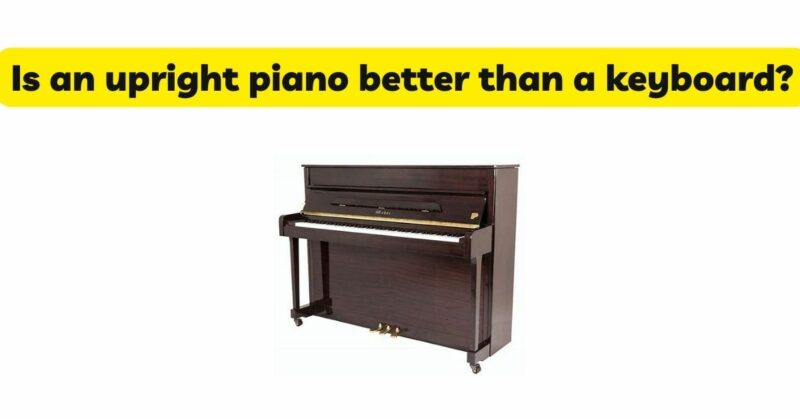The comparison between an upright piano and a keyboard is a subject of much debate among musicians and enthusiasts. Upright pianos, with their rich history and traditional appeal, are often seen as superior instruments, while keyboards offer convenience and versatility. In this article, we will explore the factors that contribute to the perceived superiority of an upright piano and assess whether it is truly better than a keyboard. By examining various aspects, we aim to provide readers with a comprehensive understanding of both instruments and help them make an informed decision based on their individual needs, preferences, and circumstances.
- Sound Quality and Authenticity: One of the primary considerations when comparing an upright piano to a keyboard is the sound quality and authenticity. Upright pianos produce a rich and resonant sound due to their acoustic mechanism and larger soundboard. The strings, hammers, and wooden construction contribute to the unique and authentic piano tone that many musicians find captivating. Keyboards, on the other hand, aim to replicate the sound of an upright piano through digital sampling and sound generation. While they have made significant advancements in sound quality, there can be subtle differences in tone, depth, and resonance compared to an acoustic instrument. However, it is worth noting that some high-end keyboards have come close to replicating the sound of an upright piano to a remarkable degree.
- Touch and Feel: The touch and feel of an upright piano are often regarded as superior due to the weighted keys and mechanical action. Upright pianos feature a traditional action mechanism that translates the player’s touch into the movement of hammers striking the strings. This mechanical feedback provides a tactile experience that many musicians prefer and allows for a wide range of dynamic expression. Keyboards, particularly those designed to emulate the feel of an acoustic piano, offer weighted or semi-weighted keys with graded hammer action. While they aim to replicate the touch sensitivity of an upright piano, some players may find the response and feel of a real piano to be more authentic and nuanced.
- Sound Projection and Resonance: Upright pianos have the advantage of sound projection and resonance due to their larger size and soundboard. The sound produced by an upright piano fills a room more naturally, creating a rich and immersive listening experience. Keyboards, being compact and often designed for personal use, may have limited sound projection and resonance. However, advancements in digital technology have led to the development of high-quality speakers and amplification systems in some keyboards, enabling them to provide a more immersive sound experience.
- Maintenance and Durability: Upright pianos require regular maintenance, including tuning, voicing, and occasional repairs. The strings, hammers, and soundboard are sensitive to changes in temperature and humidity, necessitating ongoing care and attention. Additionally, moving and transporting an upright piano can be a cumbersome and costly process. Keyboards, on the other hand, have minimal maintenance requirements. They do not require tuning and are not as susceptible to environmental factors. Keyboards are also lightweight and portable, making them easier to move and transport. In terms of durability, well-maintained upright pianos can last for generations, while keyboards, being electronic devices, may have a shorter lifespan and require occasional repairs.
- Versatility and Additional Features: Keyboards offer a range of additional features and functionalities that can enhance a musician’s versatility and creativity. Many keyboards come with various instrument voices, rhythms, built-in effects, recording capabilities, and connectivity options. These features allow musicians to explore different genres, experiment with sounds, and compose music with greater flexibility. Upright pianos, on the other hand, are focused primarily on delivering the authentic piano experience without the extensive array of additional features found in keyboards. However, it is worth mentioning that some high-end digital pianos and hybrid pianos combine the authentic touch and sound of an upright piano with additional features, bridging the gap between the two instruments.
- Cost Considerations: Cost is an important factor to consider when comparing an upright piano to a keyboard. Upright pianos, particularly high-quality instruments, can be a significant financial investment. They require a higher upfront cost and ongoing expenses for maintenance, tuning, and repairs. Keyboards, on the other hand, offer a more budget-friendly option, with a wide range of models available to suit different price points. They have lower maintenance costs and do not require tuning. For individuals with budget constraints or those who are not ready for a substantial financial commitment, keyboards provide a more accessible option.
Conclusion: The debate surrounding whether an upright piano is better than a keyboard is subjective and depends on various factors, including individual preferences, musical goals, lifestyle, and budget. Upright pianos offer an authentic and resonant sound, tactile feedback, and a sense of tradition. They require regular maintenance, have larger size and weight, and come with a higher financial commitment. Keyboards provide convenience, versatility, portability, and additional features. They have lower maintenance requirements, are more affordable, and cater to a wide range of musical styles and needs. Ultimately, the choice between an upright piano and a keyboard should be based on individual needs, preferences, and circumstances. Consider factors such as sound preference, touch sensitivity, maintenance requirements, portability, versatility, and budget when making your decision. Both instruments have their own unique qualities and can provide a fulfilling musical experience when chosen according to personal preferences and goals.


